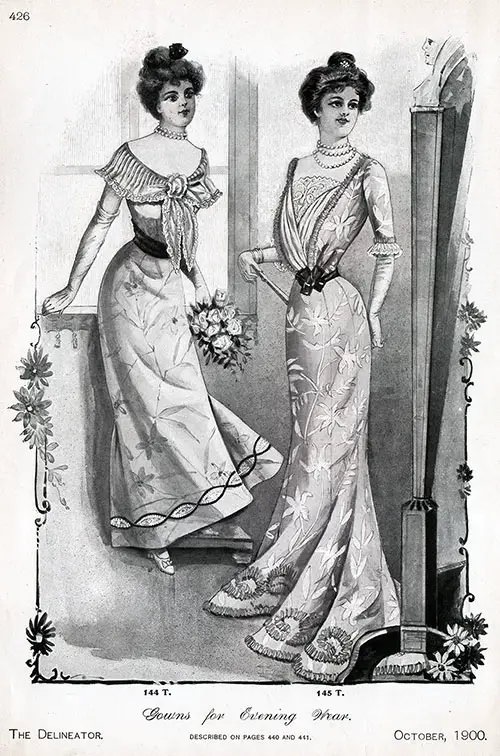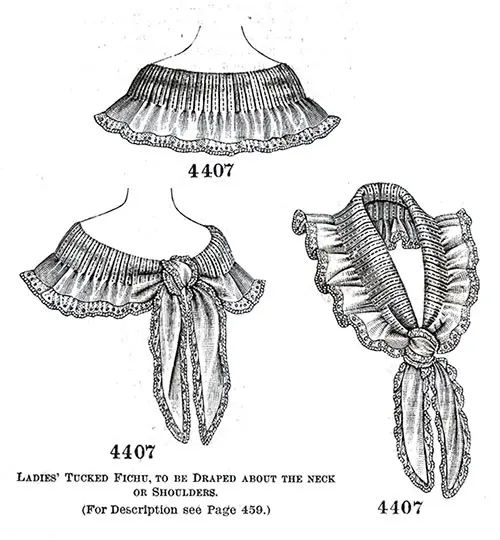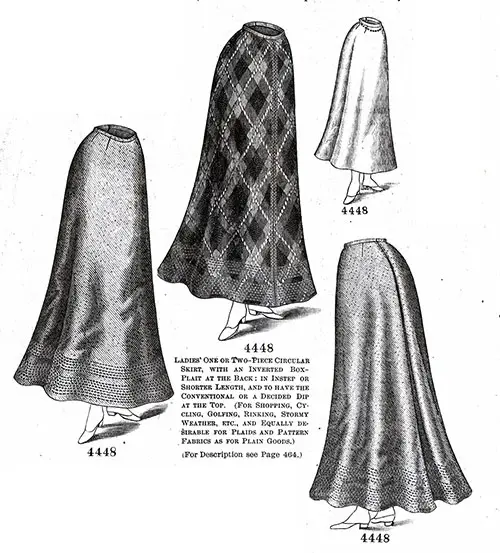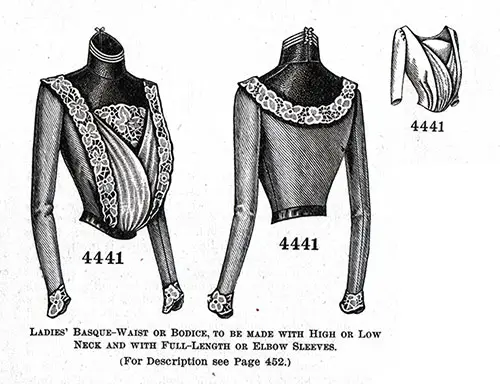Ladies Gowns for Evening Wear 144 T & 145 T - 1900

Described on Pages 440 and 441 | For Illustrations see Page 420
Ladies’ Evening Gown No. 144 T
Figure No. 144 T.—This unites a Ladies’ fichu, blouse, and skirt.
Description
The dainty fichu adds grace and becomingness to the simple blouse forming part of this striking costume, which introduces an innovation in a short skirt for evening wear.
The skirt and blouse are developed in one of the new silks showing a pale-pink background with an effective floral design in green. Black panne velvet was used for the belt and black velvet ribbon and appliqu6 lace for the skirt decoration.
The blouse has a bias back that is fitted without a wrinkle and full fronts that are shirred at the bottom. It is sleeveless and is shaped in low, rounding outline at the top to display the prettily rounded shoulders.
The closing is made invisibly a little to the left of the center in front, where the broad wrinkled belt is also secured.
The fichu meets the popular demand for tucked effects and is developed in pale-pink silk muslin with lace edging gathered to form a frill heading as decoration. It follows the upper outline of the blouse and is tucked to a pretty depth all round at the top. The tapering ends are stylishly knotted at the bust.
The skirt is of circular shaping and in one piece. It extends to the instep and is made with the fashionable dip at the top. Darts remove the fullness over the hips, and an inverted box-plait is laid at the back.
Dressmaker Options
Plain or brocaded satin. Liberty silk crepe de Chine, peau de soie, voile, vailing, mousseline de soie, point d’esprit, mull, etc., will develop charming costumes of this description for young girls, the transparent materials being used over a lining of silk, satin or other appropriate fabric.
The skirt may also be developed in double-faced cloth for rainy weather wear and all sorts of outdoor sports.
Pattern Information
The fichu pattern, which is No. 4407 and costs 5d. or 10 cents, is in one size only and is differently pictured on page 451.
The blouse pattern, which is No. 2493 and costs 10d. or 20 cents, is in seven sizes for ladies from thirty to forty-two inches, bust measure.
The skirt pattern, which is No. 4448 and costs 10d. or 20 cents, is in nine sizes from twenty to thirty-six inches, waist measure, and is again illustrated on page 462.
Ladies’ Tucked Fichu No. 4407

For Description see Page 459 | For Illustrations see Page 451
No. 4407 Ladies’ Tucked Fichu, to be Draped about the neck or Shoulders.
At figure No. 144 T in this number of The Delineator, this fichu is again represented.
Description
The gracefulness of the fichu has earned for it many admirers, its becomingness to almost every style of figure being also a decision point in its favor. For the present development of the mode white mull trimmed with narrow Valenciennes lace was chosen.
The fichu, which may be draped about the neck or shoulders, is tucked at the top from the center of the back to within a short distance of the long tapering ends, which are softly knotted at the bust. The tucks terminate at frill depth from the lower edge, the fullness below rippling gracefully about the shoulders.
Dressmaker Options
Mousseline de soie, point d’esprit, lawn, Swiss, net, tulle, and sheer fabrics of all descriptions are used for fichus.
Pattern Information
We have pattern No. 4407 in one size only.
To make the fichu requires three-fourths of a yard of material thirty-six inches wide.
Price of pattern, 5d. or 10 cents.
Ladies’ One or Two-Piece Circular Skirt No. 4448

For Description see Page 464 | For Illustrations see Page 402
No. 4448 Ladies’ One or Two-Piece Circular Skirt with an Inverted Box- Plait at the Back: in Instep or Shorter Length, and to have the Conventional or a Decided Dip at the Top.
For Shopping, Cycling, Golfing, Ice Skating, Stormy Weather, etc., and Equally desirable for Plaids and Pattern Fabrics as for Plain Goods
Other illustrations of this skirt are shown in figures Nos. 151 T and 159 T in this magazine.
Description
The practical woman recognizes the benefits to be obtained from wearing the slightly shortened skirt, and, in consequence, this useful garment is not only an acknowledged but a necessary part of the well-ordered outfit.
A skirt that will be sure to meet with appreciation is here shown made of cloth. In one instance the material is plain and in the other plaid, stitching giving the finish in both cases.
The mode is of circular shaping and is cut in one- piece but may be in two-piece style with a seam at the center of the front and back, if preferred.
A dip at the top of the front that may be conventional or more pronounced distinguishes the skirt, which is dart-fitted over the hips and has fullness at the back laid in an under-folded box-plait that is stitched for a short distance.
The skirt ripples with becoming fulness at the lower edge, where it measures about three yards in the medium sizes and may be made in instep or shorter length.
The mode is a particularly desirable one for touring, shopping, stormy weather wear and for outdoor sports of all descriptions and is equally beneficial for plaids and pattern fabrics as for plain goods.
Dressmaker Options
For golfing skirts, the favorite color is a very dark iron-gray or black. Oxford suiting will develop the mode stylishly.
Pattern Information
We have pattern No. 4448 in nine sizes for ladies from twenty to thirty-six inches waist, or thirty-seven to fifty-eight and one-half inches hip measure.
For a lady of twenty-four inches waist or forty-one inches hip, the one-piece skirt needs two yards and seven-eighths of fabric, fifty-eight inches wide; two yards and three-fourths of fabric in the same width will be required for the two-piece skirt.
Price of pattern, 10d. or 20 cents.
Ladies’ Evening Gown No. 145 T

Figure No. 145 T.—This consists of a Ladies’ Basque- blouse and skirt.
Description
Figured taffeta showing an intermingling of the delicate shades of heliotrope, green and pink was used in combination with white Liberty silk and spangled net in the present development of the costume, the exquisite coloring and perfect cut rendering the mode attractive and becoming.
The full surplice sections and smooth vest that are displayed between the pouching fronts are novel features of the low-necked blouse, which has a stretched back that is rounding at the top.
A frill of lace headed by a niching of white chiffon gives a dainty finish to the close sleeves, which are in elbow length. Similar ruchings of the chiffon are arranged on the blouse proper and in an effective manner on the skirt. A black velvet ribbon belt gives a final touch to the mode.
The skirt is eight-gored and is gracefully trained. An inverted box-plait is formed at the lower part of each side seam, and the fulness at the back is arranged in an inverted double box-plait. The skirt shows a fashionable dip at the top and dares stylishly at the foot.
Dressmaker Options
White or colored surah, foulard, chameleon faille, satin damask, Liberty satin, voile, Pompadour silks, and similar fabrics will develop beautiful evening costumes by the mode with lace frill8 or appliqué plaited chiffon, insertion, etc., for garniture.
Pattern Information
The blouse pattern, which is No. 4441 and costs 10d. or 20 cents, is in seven sizes for ladies from thirty to forty-two inches, bust measure, and may be seen differently developed on page 445.
The skirt pattern, which is No. 4430 and costs 1s. or 25 cents, is in six sizes from twenty-two to thirty- two inches, waist measure, and is again portrayed on page 454.
Ladies’ Basque-Blouse or Bodice No. 4441

For Description see Page 452 | For Illustrations see Page 445 No. 4441 Ladies’ Basque-Blouse or Bodice, to be made with High or Low Neck and with Full-Length or Elbow Sleeves.
This blouse is again shown in figure No. 145 T in this issue of The Delineator.
Description
Light Liberty satin was associated with dark panne velvet and white chiffon and all-over lace in the present development of the blouse, decoration being afforded by white velvet baby-ribbon and bands of lace applique.
The back is perfectly smooth and is in rounding outline at the top, where it displays a yoke that meets the front-yoke in a seam on the right shoulder and is closed at the left side.
The smooth vest, which is mounted on the fitted lining, overlaps the front-yoke, and is revealed between the full surplice sections that extend from the arm-hole to the lower edge of the blouse.
The surplice sections lap in characteristic fashion and are outlined by the fronts that have plaited fulness at the bottom, where they pouch attractively. The sleeves are in close two-seam style and bell prettily over the hand; they may, however, reach only to the elbow.
If the blouse is intended for evening wear, it may be made low-necked by omitting the yokes. A standing collar that is deepest at the back, where it closes, gives completion when the blouse is made with a high neck, and a ribbon belt closed at the left side follows the lower edge.
Dressmaker Options
Beige vailing combined with light- brown panne velvet and white mousseline and decorated with appliques of ecru lace will reproduce the mode stylishly. Hydrangea-blue with fancy taffeta tucking and white chiffon will combine well.
For evening wear pastel-blue crepe de Chine will be pretty associated with lace and mousseline or spangled net. Another low-necked blouse combines white Liberty silk and pale-green crepe.
Pattern Information
We have pattern No. 4441 in seven sizes for ladies from thirty to forty- two inches, bust measure.
To make the Basque-blouse for a lady of medium size will require a yard and one-fourth of fabric, forty-four inches wide with five-eighths of a yard of material twenty inches wide for the yoke and collar and half a yard in the same width for the vest, half a yard of all-over lace also twenty inches wide to cover the exposed part of the vest, and five-eighths of a yard of goods forty-five inches wide for the surplice sections.
Price of pattern, 10d. or 20 cents.
"Descriptions of Figures in Colors, Tints, Etc., Shown on First Page of Cover and Pages 423 to 437 Inclusive," in The Delineator: An Illustrated Magazine of Literature and Fashion, Paris-London-New York: The Butterick Publishing Co. Ltd., Vol. LVI, No. 4, October 1900, p. 402, 420, 440-441, 445, 451-452, 459, 464.
Editor's Note: Some terminology used in the description of women's clothing during the 1800s and early 1900s has been changed to reflect more modern terms. For example, a women's "Toilette" -- a form of costume or outfit has an entirely different common meaning in the 21st century. Typical terms applied to "toilette" include outfit, ensemble, or costume, depending on context.
Note: We have edited this text to correct grammatical errors and improve word choice to clarify the article for today’s readers. Changes made are typically minor, and we often left passive text “as is.” Those who need to quote the article directly should verify any changes by reviewing the original material.
